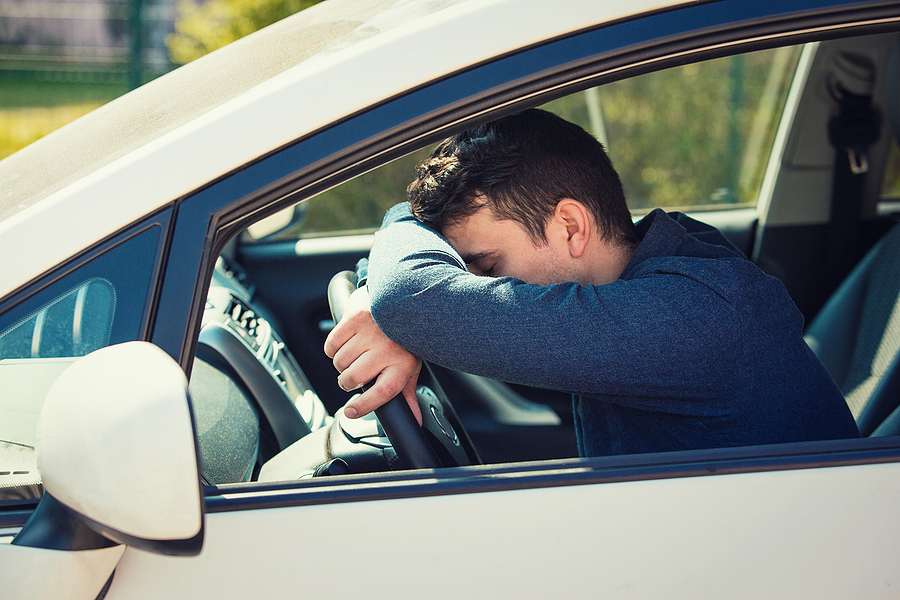
Summary:
- Rideshare driver fatigue occurs for many reasons, including financial stress.
- Uber, Lyft, and other rideshare companies work to prevent fatigue.
- If an accident occurs due to a drowsy rideshare driver, the driver, rideshare company, and other parties may face liability.
- Skilled lawyers have many tools to determine liability in cases involving accidents due to fatigue.
Rideshare services have become integral to modern transportation, offering convenience and flexibility. However, with the benefits come challenges, including rideshare driver fatigue. Researchers estimate more than 328,000 crashes involve drowsy drivers yearly, and these crashes result in 6,400 deaths.
Since rideshare drivers are on the roads much longer than typical motorists, they’re especially at risk for causing fatigue-related accidents. These crashes lead to horrible injuries and tragedies.
Sand Law attorneys can help if you’ve suffered an injury due to rideshare driver fatigue, whether you were a passenger in the rideshare or your car. We’ll work to gather the hard evidence needed to prove the at-fault driver’s liability. Schedule a free consultation by calling 651-291-7263 or contacting us online.
Long working hours, irregular schedules, and the pressure to meet high demand can contribute to the severe problem of rideshare driver fatigue.
Unlike traditional employment, rideshare drivers can choose their working hours, which may lead to extended shifts and fatigue. They may also be stressed due to financial issues and other problems. The results can be catastrophic.
How Do Ridesharing Companies Prevent Driver Fatigue?
Major rideshare companies like Uber and Lyft acknowledge the importance of addressing driver fatigue. These companies typically implement policies to regulate driver work hours and promote safety. However, the effectiveness of these policies may vary.
Uber, for example, provides tools to prevent rideshare driver fatigue. These tools include reminders for drivers to take breaks and limit their working hours. Lyft also emphasizes the importance of rest breaks in its guidelines for drivers.
Despite these efforts, preventing driver fatigue remains a challenge. Rideshare drivers are often considered independent contractors, and the nature of the job allows them to work for multiple platforms simultaneously. This flexibility can lead to extended work hours, making it challenging for companies to enforce rest periods effectively.
The Dangers of Driving While Fatigued
Driving while fatigued is akin to driving under the influence of alcohol in terms of impairment. Fatigue can result in slowed reaction times, impaired judgment, and a heightened risk of accidents. Common consequences of fatigued driving include drifting between lanes, missing traffic signals, and, in extreme cases, falling asleep at the wheel.
Rideshare drivers, who often operate in urban areas with high traffic volumes, are particularly susceptible to fatigue due to the demands of meeting passenger requests during peak hours.
Determining liability in accidents caused by rideshare driver fatigue can be complex. Rideshare drivers are considered independent contractors, which can impact the liability of the ridesharing company. If a driver causes an accident due to fatigue, several parties may be considered liable:
- Rideshare driver: The driver may bear personal responsibility if they knowingly operated the vehicle while fatigued.
- Ridesharing company: If the accident occurred when the driver was actively engaged in providing services for the rideshare company, there may be grounds for holding the company partially liable.
- Other parties: In some instances, third parties, such as maintenance providers or vehicle manufacturers, may share liability if their actions contributed to the accident.
Proving rideshare driver fatigue is critical to establishing liability and seeking compensation. A comprehensive approach to gathering evidence is essential. Here are detailed explanations of the steps involved:
Eyewitness Testimony
Eyewitnesses can be crucial in providing firsthand accounts of the driver’s behavior leading up to the accident. Witness statements may include observations of signs of fatigue, such as erratic driving, drifting between lanes, slowed reaction times, or even visible signs of drowsiness.
Collecting detailed and credible eyewitness accounts can strengthen your case by providing tangible evidence of the driver’s condition.
Driver Records
Accessing the rideshare driver’s records is vital for understanding their work hours and patterns. Rideshare companies often maintain detailed records of driver activity, including log-in and log-out times, total hours worked, and engagement patterns.
Analyzing these records can reveal if the driver was working extended hours, taking insufficient breaks, or consistently driving for too many hours. These records are tangible evidence of the driver’s work history and potential for driving while drowsy.
Accident Reconstruction
Accident reconstruction involves employing professionals with expertise in recreating the events leading to an accident. In cases of accidents where rideshare driver fatigue is suspected, accident reconstruction experts can analyze factors such as the driver’s speed, reaction time, and decision-making leading up to the incident.
This analysis can reveal patterns consistent with driver fatigue, such as delayed reactions or failure to respond appropriately to changing road conditions. Accident reconstruction provides a scientific and objective perspective on the accident’s circumstances.
Electronic Logging Data
Many rideshare companies utilize electronic logging systems to track driver activity. This data includes information about when a driver accepts a ride, starts driving, takes breaks, and concludes their working hours. These systems are similar to the electronic data recorders used in commercial trucks.
Obtaining this electronic logging data is crucial for constructing a timeline of the driver’s activities leading up to the accident. Anomalies or patterns of prolonged activity without breaks can indicate potential fatigue. This electronic trail is concrete evidence of the driver’s actions and adherence to or violation of the rideshare company’s policies.
Medical Records
In cases where a rideshare driver has a history of fatigue-related medical conditions, obtaining relevant medical records becomes a key element. Medical records can provide insights into the driver’s health, including diagnosed sleep disorders, medications that may cause drowsiness, or other health issues contributing to fatigue.
Establishing a connection between the driver’s medical history and the potential impact on their ability to drive safely strengthens the case. Medical records contribute to a more comprehensive understanding of the driver’s physical and mental condition at the time of the accident.
Contact an Experienced Ridesharing Accident Lawyer ASAP
If you’ve been involved in an accident caused by rideshare driver fatigue, contact Sand Law. An experienced rideshare accident lawyer with our firm can navigate the complexities of the case, gather evidence, and work to help you get the money you deserve.
Please schedule a free case review by using our online form or calling 651-291-7263.
Frequently Asked Questions
Yes, the court can hold a rideshare driver liable if an investigation proves their fatigue directly contributed to the accident.
What steps should I take immediately following an accident with a ridesharing driver?
After a rideshare vehicle accident:
- Prioritize your safety and the safety of others involved.
- Seek medical attention, contact law enforcement to report the incident, gather contact information from witnesses, and document the scene.
- Avoid discussing fault with the police – or anyone else – and contact a lawyer immediately.
What responsibilities do ridesharing companies have to prevent driver fatigue?
Ridesharing companies must implement and enforce policies promoting driver safety, including measures to prevent fatigue. However, the effectiveness of these policies may vary, and they may share responsibility with drivers.

